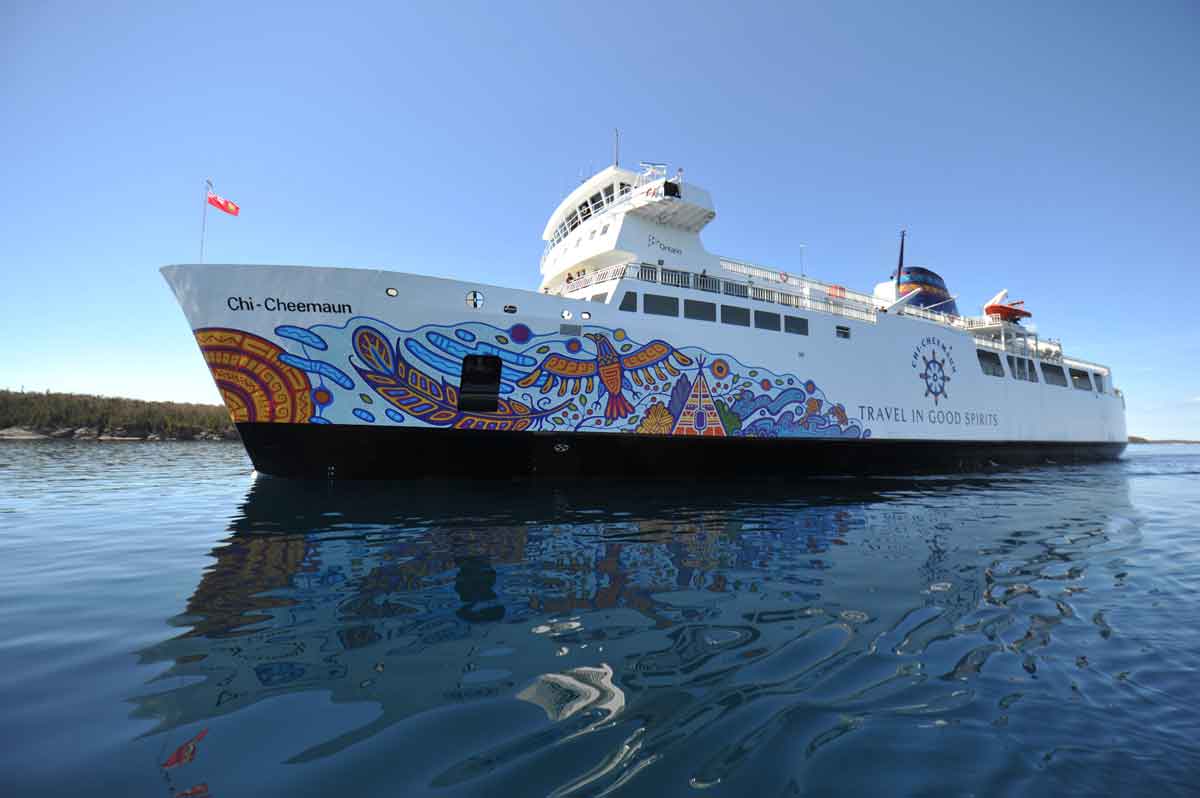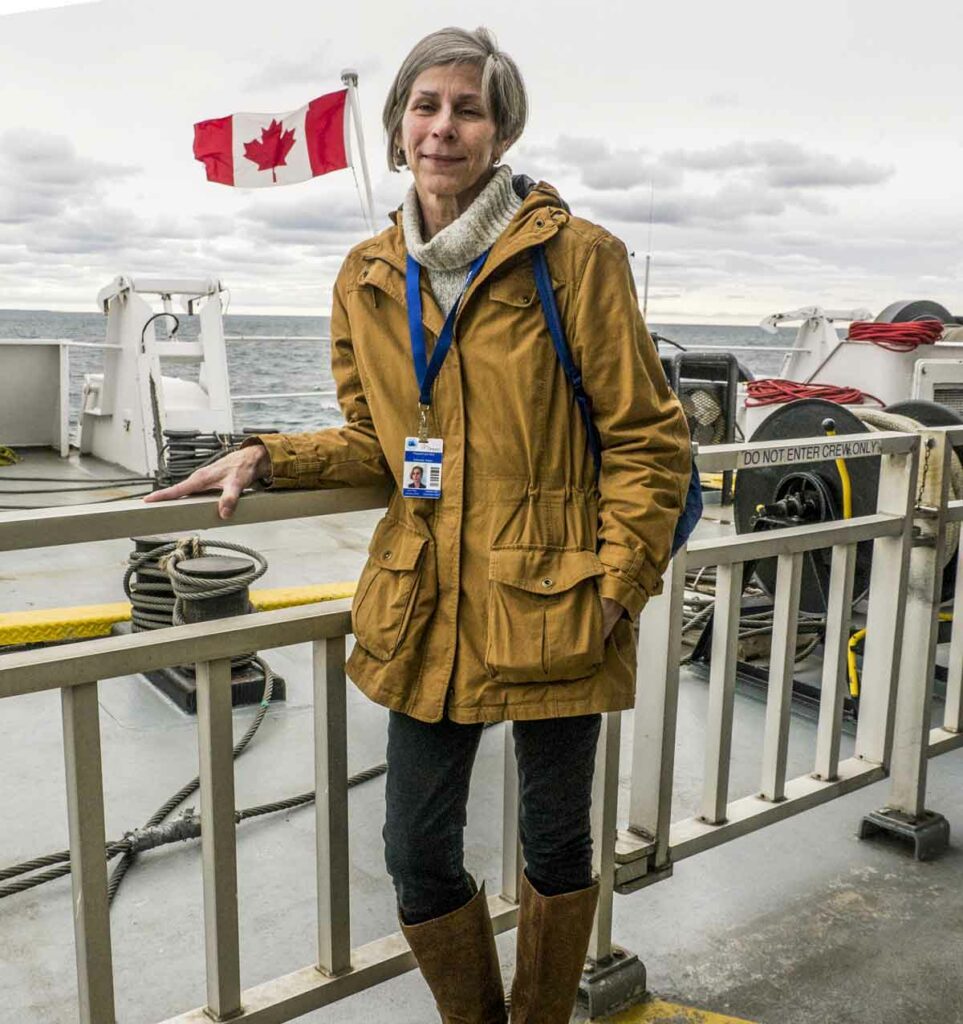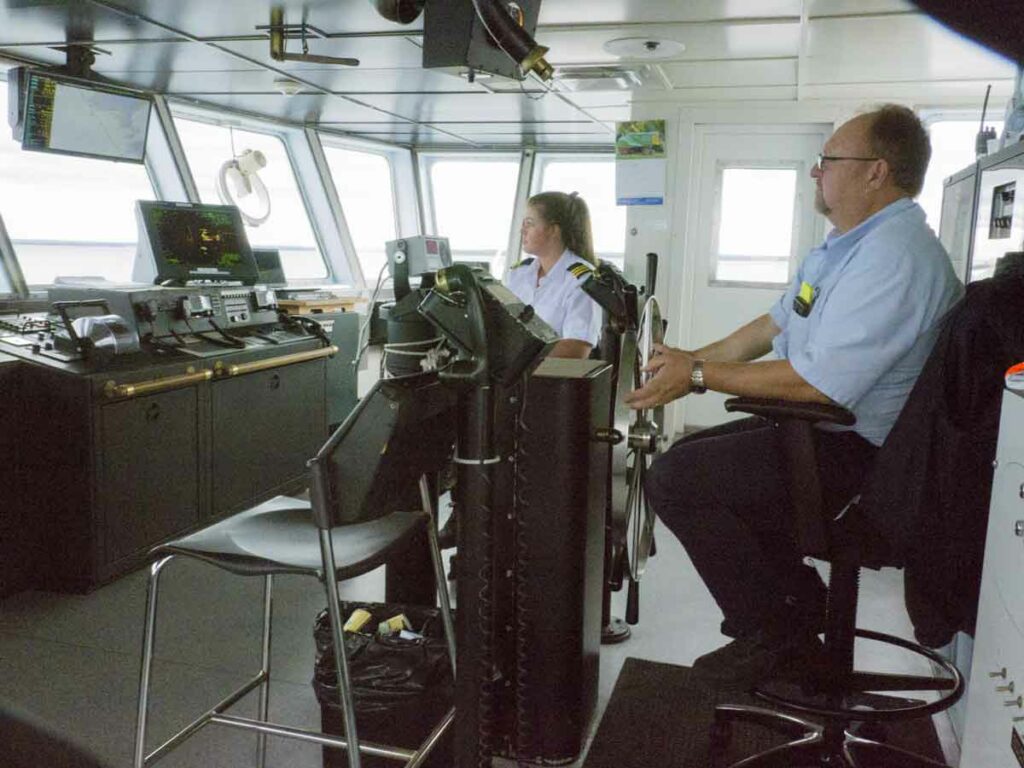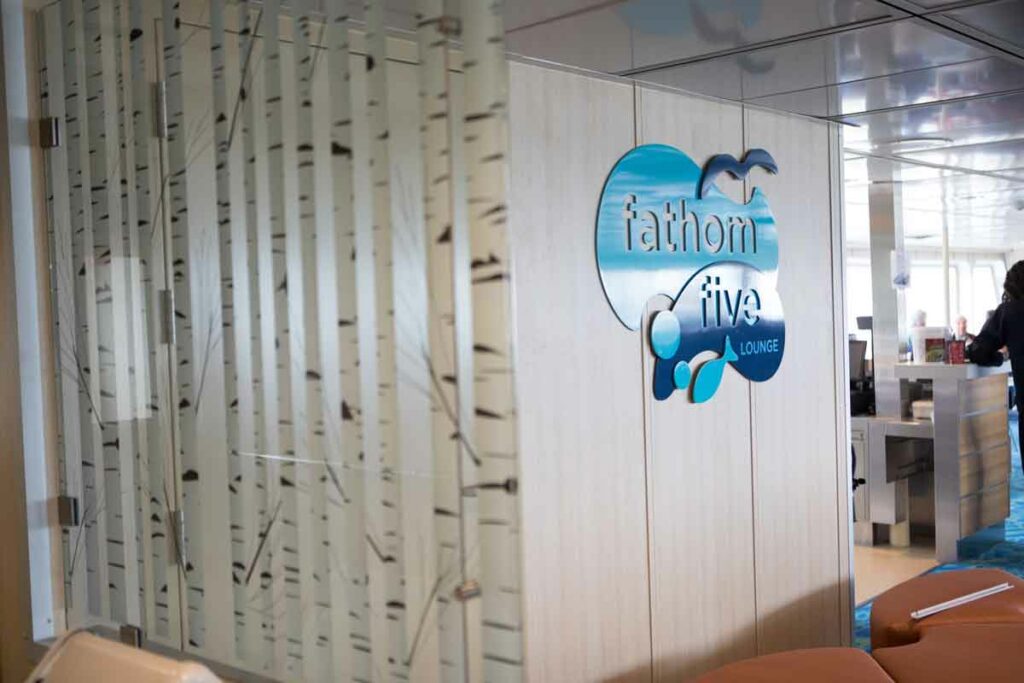By Isobel Harry, This is Manitoulin April 2021
For thousands of years, the spectacularly beautiful waters of the Georgian Bay and North Channel of Lake Huron have served as major transportation routes—a lifeline for fishing, hunting and trade for this region’s first inhabitants, the ancestors of today’s Anishinaabek. Much later, beginning after European contact in the early 1600s, the waterway, coursing between Killarney and Sault Ste. Marie and nestled by the weathered two-billion-year-old rocks of the Canadian Shield, saw the huge canoes of the French fur traders, the commercial traffic of the booming lumbering and fishing industries and of shipments of iron ore, grain and limestone.
By 1850, the steamboat ‘Gore’ was taking passengers between Georgian Bay and Sault Ste. Marie via Manitoulin Island. But it was when the Owen Sound Transportation Company, founded in 1921 (its 100th anniversary is this year), began to accommodate passengers and ever-increasing numbers of cars on their new ferry service between Owen Sound and Sault Ste Marie, that tourism really took off in this region.
Boating as a leisure activity on the waters of the North Channel gained momentum then too. Today, Lake Huron’s North Channel is “the jewel of Ontario,” considered “magical” and “intoxicating” by those lucky enough to cruise its 160-nautical-mile length and “the world’s best freshwater cruising” by leading nautical magazines and boating aficionados the world over.
“We’re mesmerized by it,” laughs Becky Middlebrook over the phone from her home in Owen Sound. For the last 25 years, Becky and Paul Middlebrook have sailed in Georgian Bay and the North Channel and are current vice commodore and past commodore, respectively, of the “wonderful Georgian Yacht Club” in Owen Sound.
Their first trip was “part-terrifying,” explains Becky. “Unlike Paul, I was not a seasoned sailor; it rained for three days solid and it was very intimidating!” The following year, they went back with experienced sailors; that trip whetted their urge to return ever since. Starting out with an “entry-level” 24-foot vessel, they now sail the 34-ft ‘Nyala’ – “just the right size for the North Channel” – west to Spanish and beyond, staying in favourite anchorages like the Whalesback Channel.
The Middlebrooks cite tranquility, outstanding natural features and wildlife as the main motivators of their annual pilgrimage, and the social aspect of meeting up with other boaters. “We enjoy being by ourselves, too, and every morning we love the smell of the bush, we see deer on the shoreline, the mountains in the distance,” says Becky. Adds Paul, “You’re in your own oasis on your boat; we anchor and go swimming and kayaking. The water is so clear and fresh. It’s almost surreal.”
Becky usually sails up the Bruce Peninsula with her “girls’ crew” first, while Paul works a little longer in the city, joining her later. They chart a course to Cabot Head for an overnight, then up to the north shore to spend a couple of days in Fraser Bay near Killarney. In the summer of 2020, Becky made the journey alone. “It was perfect weather, I took my time, it was all very controlled. Paul came up by ferry and we spent four weeks on the boat.”
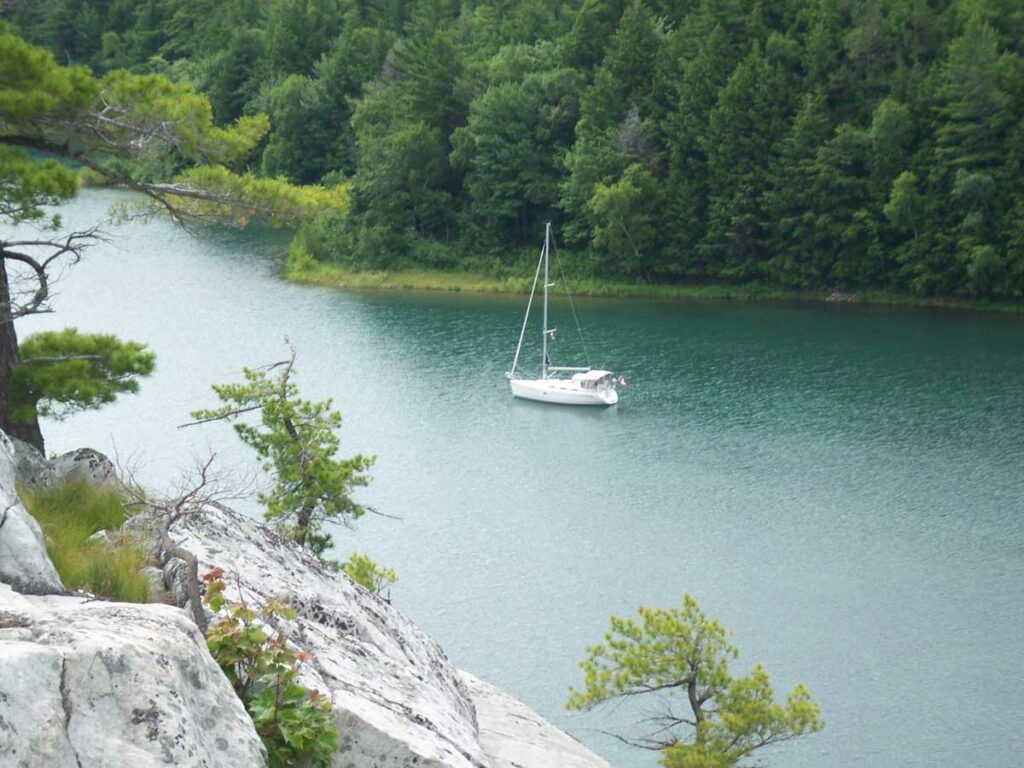
Keeping boaters safe on the North Channel is the number one mission of the Cruisers’ Net, broadcasting from Little Current on VHF Channel 71. During the pandemic’s much quieter summer of 2020, with lower than usual numbers of sailors in the North Channel, for Roy Eaton, the anchor of the daily summer marine broadcast and boaters’ help network for the last 17 years, it was business almost-as-usual.
The biggest change was staying home instead of walking to the station in the Anchor Inn. “The antenna at home is the same height as the one at the Anchor Inn, 110 feet,” says Roy.
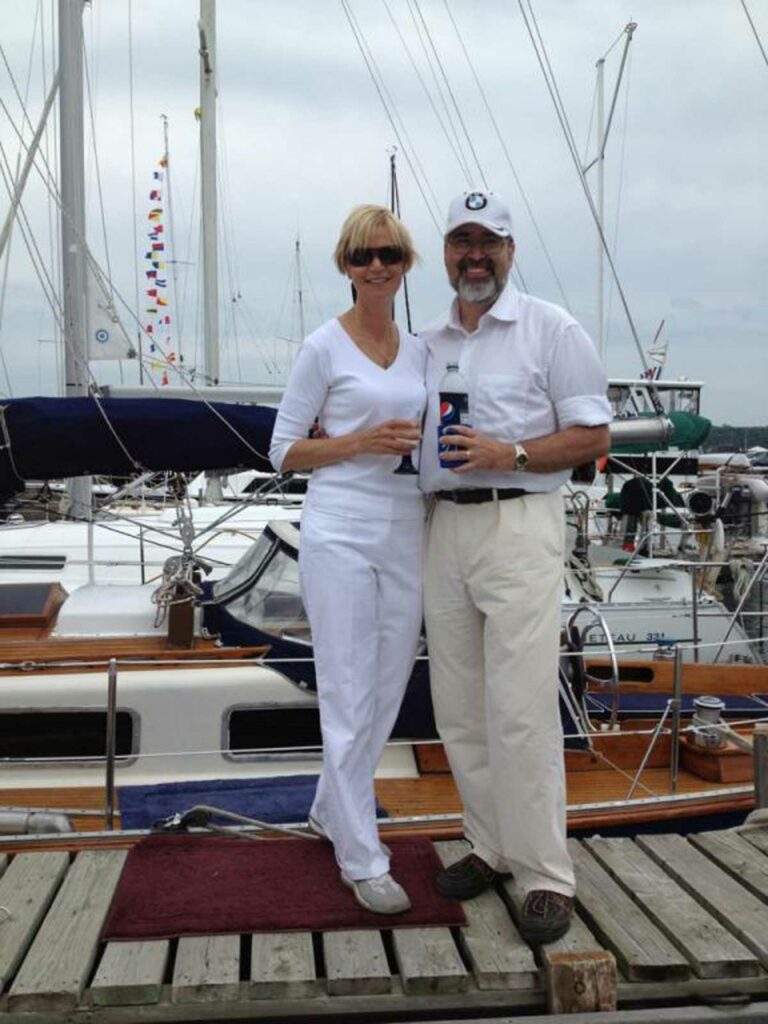
They spend summers aboard their cruiser ‘Nyala’ in the North Channel. By Isobel Harry.
When Becky Middlebrook sailed solo last summer, she says, “I’d call Roy to let him know I’m leaving, where I am and when I get there. At 9 am you get the news, weather and the opportunity to connect with people and help each other.”
The two-hour broadcast and call-in begins at 9 am five days a week in July and August with the question: “Any emergency, medical or priority traffic?” As a fully licenced shore station registered with the Canadian and American Coast Guards and the Air Search and Rescue unit out of Trenton, Cruisers’ Net mobilizes “ready assistance” in case of trouble on the water. After the marine forecast for the North Channel and northern Georgian Bay, local and world news, sports and local events, boaters call in with their locations and itineraries. Volunteers at the station record all the calls, questions, concerns and relays to fellow boaters who are out of range of their yacht’s transmission.
“I set up a site on Zoom last summer,” says Roy Eaton, “so people could tune in. About a dozen boaters would log in for the broadcast, and some were calling in from Alabama, Michigan or Missouri just because they missed the North Channel so much and wanted to say hello.”
The increased camaraderie afforded by the screens accessed on iPads, laptops or phones has convinced Roy to continue using Zoom “from now on.” After each broadcast last summer, sailors on Zoom would show their paintings, for instance, or hold up the phone in a game of ‘Guess That Anchorage.’
Cruising veterans Bob and Kathy Hall of Orillia have been sailing together since 1978 and wax similarly poetic about their North Channel experiences. While Kathy grew up with boats, Bob tried out his first sailboat at age 40, a 22-ft craft that took them to the North Channel for the first time. The now-annual tradition first lasted two weeks, “while the kids were at camp,” since expanded to the entire summer aboard the 36-ft ‘Georgian Mist,’ berthed in Little Current.
“It just blew us away,” says Kathy of their first sighting of the North Channel at Killarney, to which they’d driven their boat after Bob had read about it in a boating magazine, “despite the bad road at the time.”

“It was just so beautiful. One great anchorage after another. We were amazed—why on Earth didn’t we know about this before?” Now, favourite spots include Hotham Island near Sagamok First Nation and breathtaking Baie Fine, North America’s only fjord, Covered Portage Cove in Killarney and the stunning Benjamin Islands “when the anchorage is good.” They visit Manitoulin marinas by boat and tour the Island by car, once taking in the Wiikwemkoong Cultural Festival, and seeing the sights.
Greatly enhancing their comfort on the water, the Halls check in with Cruisers’ Net, “almost daily when we’re in range and by email with Roy if we’re not. Roy takes check-ins from certain areas at a time. There’s a community out there that is ready to help, and thanks to the Net, the fellow boaters in the North Channel are friends, some of whom we just haven’t met yet!”
“The North Channel stacks up against anywhere, and we’ve seen a lot—the Bahamas, Chesapeake Bay, Florida, Australia, New Zealand, Scotland,” say the savvy sailing couple. Swimming in the clear, deep blue water of the North Channel and “poking around” in a dinghy, “visiting very dear summer friends” anchored in coves among the picturesque islands dotted between the North Shore and Manitoulin Island to the south, and so summer drifts along, gently bobbing on the waves under the dazzling sun, moon and stars.
No boat? No Problem!
North Channel Tours’ 2021 boating excursions will put the wind in your sails:
northchanneltours.com/calendar
Sailboat rentals: Canadian & Yacht Charters (CYC): cycnorth.com
Cruisers’ Net: VHF Channel 71
exploremanitoulin.com/boating
thenorthchannel.ca/


